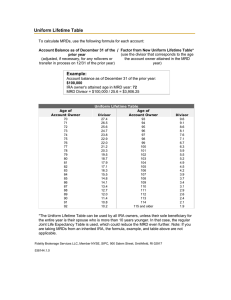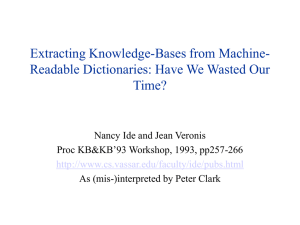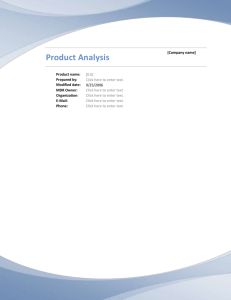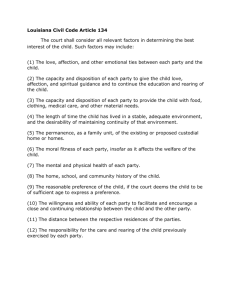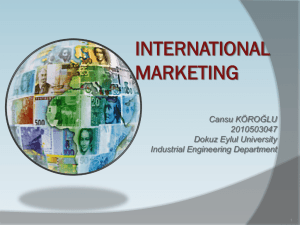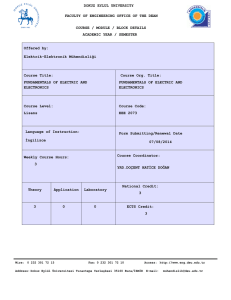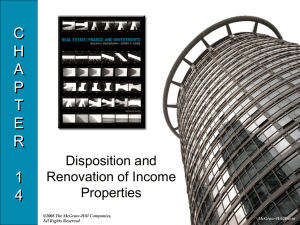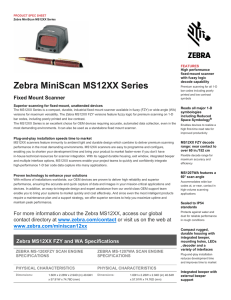presentation
advertisement
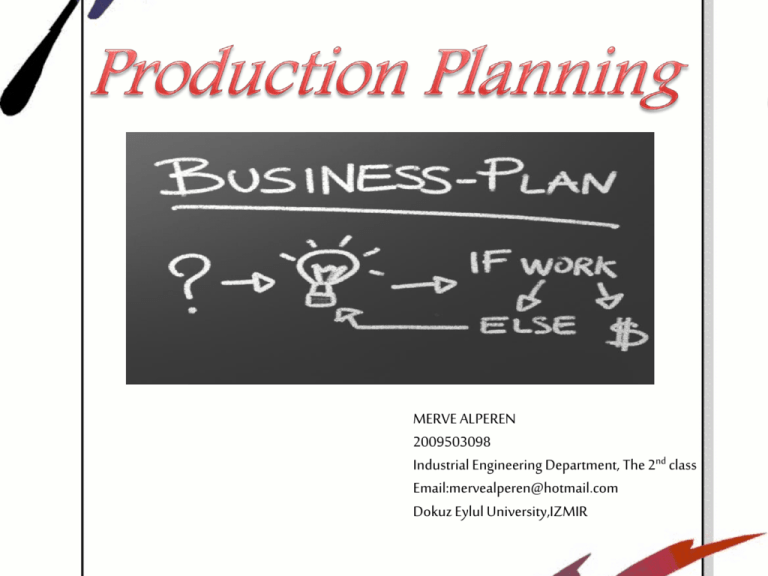
MERVE ALPEREN 2009503098 Industrial Engineering Department, The 2nd class Email:mervealperen@hotmail.com Dokuz Eylul University,IZMIR WHAT IS PRODUCTION PLANNING? Product Planning is the incessant process of identifying and articulating market requirement that define a product’s feature set. At its core, production planning predicates the beating heart of any manufacturing process. Its purpose is to minimise production time and costs, efficiently organise the use of resources and maximise efficiency in the workplace. An Information Product Plan will thus provide continuity for all parts of the product's life cycle, prevent fragmentation or duplication of effort, and identify funding needs. Life cycle elements include the following: A: Planning B: Development C: Dissemination D: Documentation E: Storage F: Evaluation G: Disposition A. Planning entails the early identification of purpose, targeted audience(s), suitable media, and costs. B. Development includes information acquisition, creation, peer review, editing, clearances (copyright, image releases, and other legal concerns), design, layout, printing, programming, manufacturing, and other production processes. C. Dissemination encompasses a range of activities including advertising product usability, serving and maintaining electronic documents, conducting initial mailings (including copies to custodian libraries), stocking sales outlets, and managing requests. D. Documentation concludes cataloging, entering bibliographic information into various USGS databases, indexing, and collecting metadata according to national and Federal standards. E. Storage addresses warehousing, inventorying, and ongoing archiving. F. Evaluation includes determining the effectiveness of products. G. Disposition is the periodic determination of the need for an information product to be reeditioned, revised, or removed from inventory. Competitive analysis is also an important part of product planning. Your customers, sales channels, and prospects evaluating your product will tell you where you fall short competitively. Additionally listen to your prospects when they are asking you about your product features and directions. Often times they are parroting back information that your competitor's have given them. Market analysis is also important. Trends in the industry need to be factored into your product plans. Your engineering group will also provide some good ideas in this area; they are generally on top of many of the new technologies PRODUCTION PLANNING AND CONTROL’S MAIN FUNCTIONS •Forecasting to predict customer demand on various products over a given horizon. •Aggregate Planning to determine overall resources needed. •Materials Requirement Planning to determine all required components and timing. •Inventory Management to decide production or purchase quantities and timing. •Scheduling to determine shop-floor schedule of various components MARKET REQUIREMENTS REFINED Once the product is approved you can refine the market requirements, adding more detail on the desired features of the product and how the customers will use the product.There will be two types of MRDs, one for new products and a second for new releases of a current product. DEVELOPMENT INITIATED Once the MRD is complete, the developers can start to work on a functional specification and prototypes. Some companies combine the MRD and Functional Specification into one document to help them decrease time to market. To do this, you must work very closely with engineering to make sure that the functional design of the product will indeed meet customer requirements. PRODUCT DESCRIPTION You need enough information so that the product can be easily described in one or two sentences to customers or other people within the company. Who buys the product? Why is the product of value to the buyer? Why is it better than the competition? MARKET JUSTIFICATİON Why should the company build this product? Who needs it? How much will they buy? Including market numbers and real sales projections will help you determine the size and the viability of the market. RESOURCE PROJECTION: Work with the engineering organization to get an initial very rough estimate on what it will take to build the product in terms of people-years. You will probably meet some resistance with this. No engineering manager wants to sign up to a schedule for a product that is not well defined. THE PREPARATION You need to prepare all the slides in advance of the meeting.This is necessary for the following reasons: *Engineering needs to provide resource estimates. *Engineers may have great ideas on a particular implementation of a product or even a good target market for the product. *Engineers may have strong opinions on a given project. It is best to understand those before trying to get the project approved. •Project Name •Product Description •Recommendation •Market Justification •Resource Projection THE DECISION •If the product fits into the company strategy, but the resources are unavailable to work on it, it may be a good idea to put it on hold until some determined future time. •The decision should take into account the following criteria •Does the project fit into the company's long term strategy? •Does the target market for the project align with the company strategy? •Will there be sufficient revenue from the product to justify the work required? •If there is not sufficient revenue, are there other highly compelling reasons to justify the work? •Are the resources available to do the work? •If the resources are not available, should this project take precedence over another? THANK YOU
